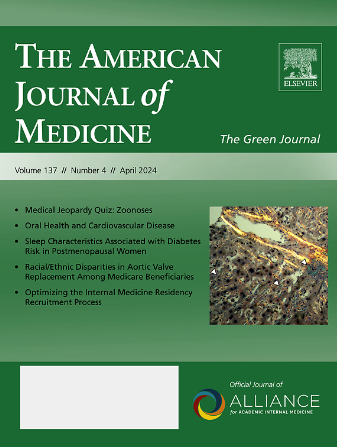1999-2020 年美国青壮年艾滋病毒相关死亡率的人口和地区趋势。
IF 2.5
3区 医学
Q1 MEDICINE, GENERAL & INTERNAL
引用次数: 0
摘要
背景:以往的研究对感染 HIV 的老年人的死亡率模式进行了调查,揭示了地区和人口方面的差异。本研究旨在评估 1999 年至 2020 年间青壮年艾滋病毒相关死亡率的人口和地区趋势:采用疾病预防控制中心的 WONDER 数据库,使用《疾病和相关健康问题国际统计分类-第 10 次修订版》(ICD-10)中的 B20-B24 编码,确定 1999 年至 2020 年期间艾滋病毒被称为根本死因或促成死因的 15-44 岁青壮年。确定了每 10 万人的年龄调整死亡率(AAMRs)和年度百分比变化(APC):1999-2018年期间,青壮年艾滋病患者的年龄调整死亡率持续下降,2018-2020年期间趋于稳定(APC:0.5%;95% CI,-7.4-9.0),其中64%的死亡发生在医疗机构。总体而言,男性的 AAMR 是女性的两倍(女性:2.22,95% CI 2.19-2.24;男性:5.19,95% CI 5.15-5.23)。非西班牙裔(NH)黑人的死亡率是白人的七倍(AAMR:14.88 对 2.036)。南部地区的死亡率是中西部地区的三倍。大都市成年人的 AAMR 是非大都市成年人的两倍。艾滋病毒相关死亡率排名前 90 位的州,包括密西西比州、马里兰州、佛罗里达州、路易斯安那州和哥伦比亚特区,与排名后 10 位的州,如北达科他州、爱达荷州、怀俄明州、蒙大拿州和犹他州相比,死亡率高出六倍:结论:为解决这些差距并确保持续进步,需要采取紧急措施。本文章由计算机程序翻译,如有差异,请以英文原文为准。
Demographical and Regional Trends of HIV-Related Mortality Among Young Adults in the United States From 1999 to 2020
Background
HIV remains a leading cause of death in the U.S. Previous research has examined mortality patterns among older adults with HIV, revealing regional and demographic disparities. This study aims to assess demographic and regional trends in HIV-related mortality among young adults from 1999 to 2020.
Methods
Centers for Disease Control and Prevention Wide-Ranging Online Data for Epidemiologic Research database was used to identify young adults aged 15-44 where HIV was mentioned as either underlying or contributory cause of mortality between 1999 and 2020, using the B20-B24 codes from the International Statistical Classification of Diseases and Related Health Problems-10th Revision (ICD-10). Age-adjusted mortality rates (AAMRs) per 100,000 population and annual percentage change (APC) were determined.
Results
The AAMRs for HIV in young adults consistently declined from 1999 to 2018, followed by a period of stability from 2018 to 2020 (annual percentage change: 0.5%; 95% confidence interval [95% CI], –7.4 to 9.0), with 64% deaths occurred in medical facilities. Overall, males had a twice AAMR than females (female: 2.22, 95% CI 2.19-2.24; male: 5.19, 95% CI 5.15-5.23). Non-Hispanic (NH) Blacks had sevenfold higher mortality rates than Whites (AAMR 14.88 vs. 2.036). The Southern region experienced threefold higher mortality compared to the Midwest. Metropolitan adults had a twofold higher AAMR than nonmetropolitan adults. States in the top 90th percentile for HIV-related mortality, including Mississippi, Maryland, Florida, Louisiana, and the District of Columbia, exhibited six times higher mortality compared to states in the bottom 10th percentile, such as North Dakota, Idaho, Wyoming, Montana, and Utah.
Conclusions
To address these disparities and ensure continued progress, urgent measures are required.
求助全文
通过发布文献求助,成功后即可免费获取论文全文。
去求助
来源期刊

American Journal of Medicine
医学-医学:内科
CiteScore
6.30
自引率
3.40%
发文量
449
审稿时长
9 days
期刊介绍:
The American Journal of Medicine - "The Green Journal" - publishes original clinical research of interest to physicians in internal medicine, both in academia and community-based practice. AJM is the official journal of the Alliance for Academic Internal Medicine, a prestigious group comprising internal medicine department chairs at more than 125 medical schools across the U.S. Each issue carries useful reviews as well as seminal articles of immediate interest to the practicing physician, including peer-reviewed, original scientific studies that have direct clinical significance and position papers on health care issues, medical education, and public policy.
 求助内容:
求助内容: 应助结果提醒方式:
应助结果提醒方式:


